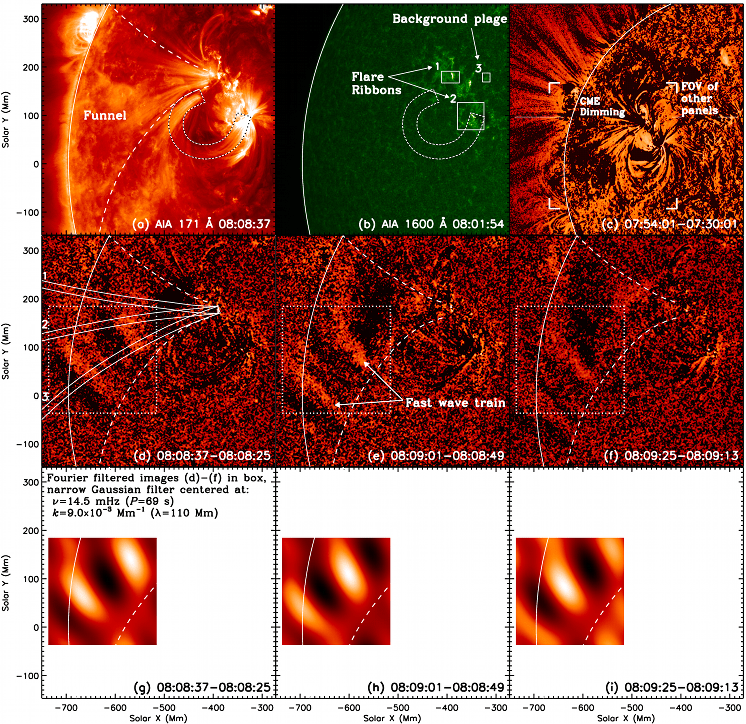[/caption]
Time to grab your silver surfboards because scientists utilizing the Atmospheric Imaging Assembly (AIA) instrument on-board NASA’s Solar Dynamics Observatory (SDO), have picked up on quasi-periodic waves in the low solar corona that travel at speeds as high as 2,000 kilometers per second (4.5 million miles per hour). Just think… We could ride that tasty wave to the Moon and back about 16 times during lunch break and still have time for coffee!
Presenting the findings today at the annual meeting of the Solar Physics Division of the American Astronomical Society is Dr. Wei Liu, a Stanford University Research Associate at the Lockheed Martin Solar and Astrophysics Laboratory (LMSAL) at the company’s Advanced Technology Center (ATC) in Palo Alto. His research has provided concrete evidence of propagating fast mode magnetosonic waves at such high speeds in the Sun’s low atmosphere. We’ve known for awhile that hot plasma will produce a “ripple effect” – much like a bubble popping to the surface when heating gravy. While computer simulations, models and theories speculated how it occurred, it wasn’t until now that these waves have been directly observed. Why? Because we simply weren’t quick enough.
“It is the high temporal and spatial resolution of AIA that enables us to see these waves clearly for the first time. AIA takes high sensitivity, extreme ultraviolet (EUV) pictures of the solar corona at spatial scales down to 1,100 kilometers, every 12 seconds with 0.1-2 second exposures,” said Dr. Liu, who led the analysis of the waves. “In addition, AIA’s full Sun field of view at seven simultaneous wavelengths allows us to track them over large spatial and temperature ranges.”
Just check this bad boy out…
Lasting anywhere from 30 to 200 seconds, the hot arches center around flare nuggets and follow the wake of coronal mass ejection areas… traveling along the magnetic loops. “Their characteristic spatial and temporal scales and dispersion relation agree with theoretical expectations of fast mode magnetosonic waves, and are reproduced in our high fidelity 3D computer simulations,” said Prof. Leon Ofman of the Catholic University of America, part of the team that made the discovery. “They seem to be a common phenomenon. During the first year of the SDO mission, despite the Sun being relatively quiet, we have seen about a dozen such waves,” said Dr. Karel Schrijver, principal physicist of LMSAL. “Although their exact trigger mechanism is currently under investigation, they appear to be intimately related to flares that sometimes exhibit pulsations at similar frequencies.”
These types of waves are quite probably responsible for elemental – yet still mysterious – processes on the solar surface, such as heating the corona to millions of degrees, accelerating the solar wind, triggering remote eruptions, and delivering energy and information between different parts of the atmosphere. Through direct observance, we’re able to begin to unravel the physics and advance our knowledge of the Sun-Earth connection.
“This discovery and analysis is very significant because we are witnessing phenomena of which we were previously unaware. In light of this discovery, the more we look at solar flares, the more of these waves we see, and as observation and analysis lead to insight, the better we will understand the processes involved,” said Dr. Alan Title, AIA Principal Investigator at LMSAL who first noticed the fast propagating waves in routine AIA movies. “The findings announced today are an example of the fruit of a two decade long collaboration, of which we are enormously proud, between Lockheed Martin and Stanford University.”
What a ride…
Original Story Source: Lockheed Martin Solar and Astrophysics Lab.


I was not aware with this useful information.. It’s really useful for science student and also important for who take interest in astronaut knowledge.
http://skinny-fiber.posterous.com/skinny-fiber-review-ward-off-excessive-fat-an
Yo Uncle_Fred — ANOTHER SPAM ALERT!